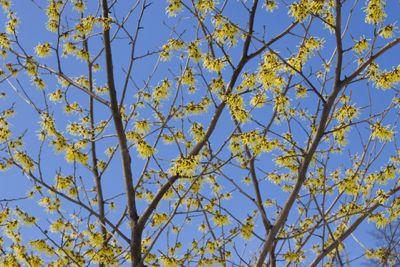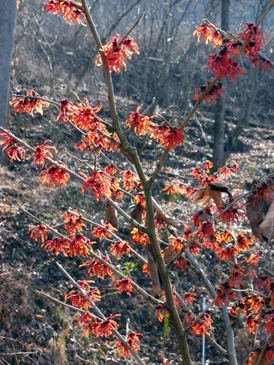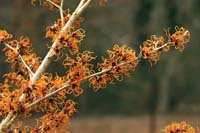A mild winter has its perks – low heating bills and more outdoor excursions, just to name a couple. But some of the plants in our front yard have become a little disoriented by these warm days. Our daffodil leaves have emerged just recently (and it’s only January), and so have our calendulas and alehoof growing in the front yard. The future doesn’t look promising for these young plants – the next cold nip will surely be the end of their display. There are plants, however, that regardless of mild or cold temps, give their floral displays every winter. Some of my favorites for the winter landscape are in the witch hazel family. There are so many varieties available today (well over 30!) that I’m a little out of practice. There are numerous colors and fragrances, with several stemming from our native witch hazel, Hamamelis virginiana.

The native Virginia witch hazel, Hamamelis virginiana, is a large shrub/small tree that flowers in early winter, with delicate star-like yellow blooms that make me think of “pom-poms.” The vernal witch hazel, Hamamelis vernalis, is another native witch hazel that blooms typically in January, with fragrant yellow to red flowers. Several cultivars have flowers ranging from orange to purple and even include enhanced ‘spicy’ fragrances from the species. These odorous traits are delicate but alluring, with scents similar to culinary delicacies, such as the Gingerbread witch hazel (Hamamelis x intermedia ‘Gingerbread’ ) and the Diane Red Flowering witch hazel (Hamamelis x intermedia‘Diane’), with scents of vanilla and clove. I’ve always wanted to bring branches into the house to brighten things up a bit, but I can never bring myself to cut these beautiful displays.


With more and more exotic evergreen choices flooding the horticultural market, don’t forget about the more subtle and unique native witch hazel varieties for winter interest. Similar to azaleas and rhodos, they primarily need the same requirements: acidic, well drained soils, and partial sun (typically full morning sun is optimal for blooms). Witch hazels look great with finer textured evergreens in the background, such as an eastern red cedar (Juniperus virginiana) or white pine (Pinus strobus). Also try mixing them with winter fruiting displays, such as the winterberry holly (Illex verticillata). They can really be a great component to your winter landscape and add a bit of colorful cheer to overcome those winter blues.
-Dena Chandler, Landscape Designer, LEED-AP
